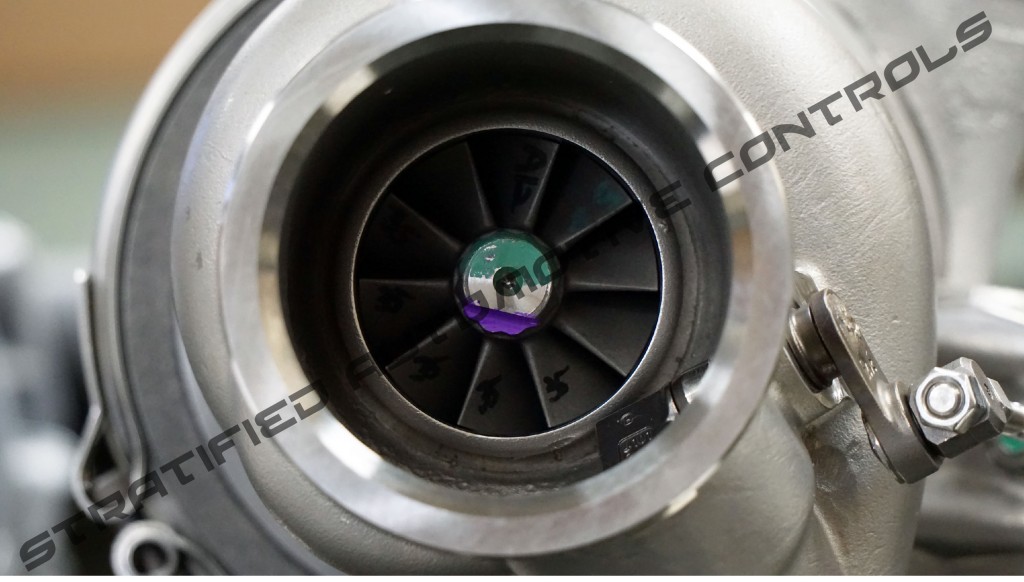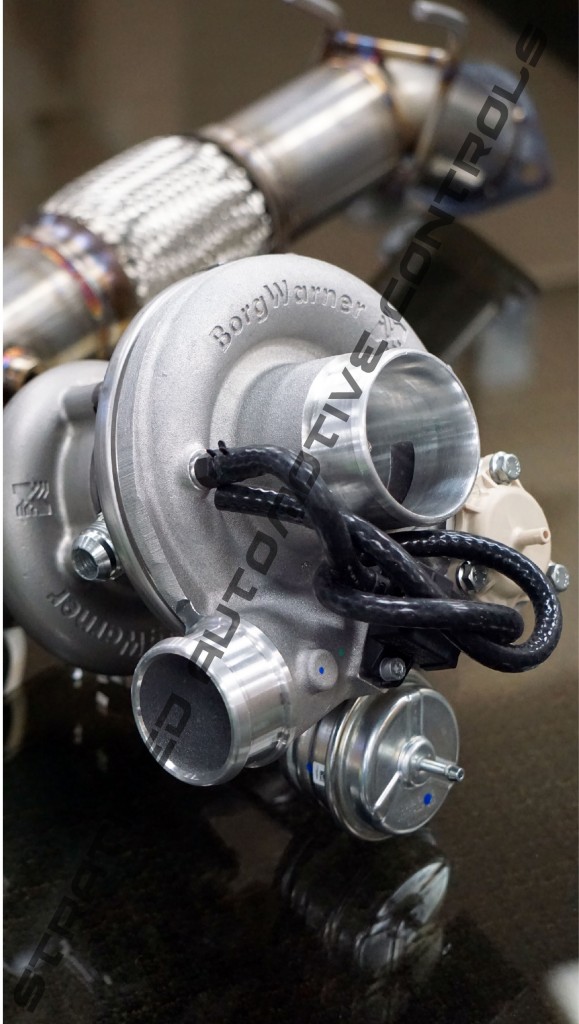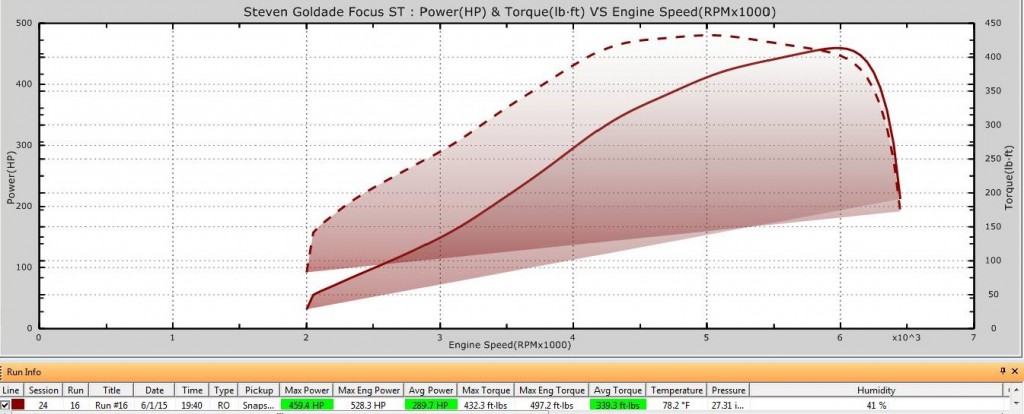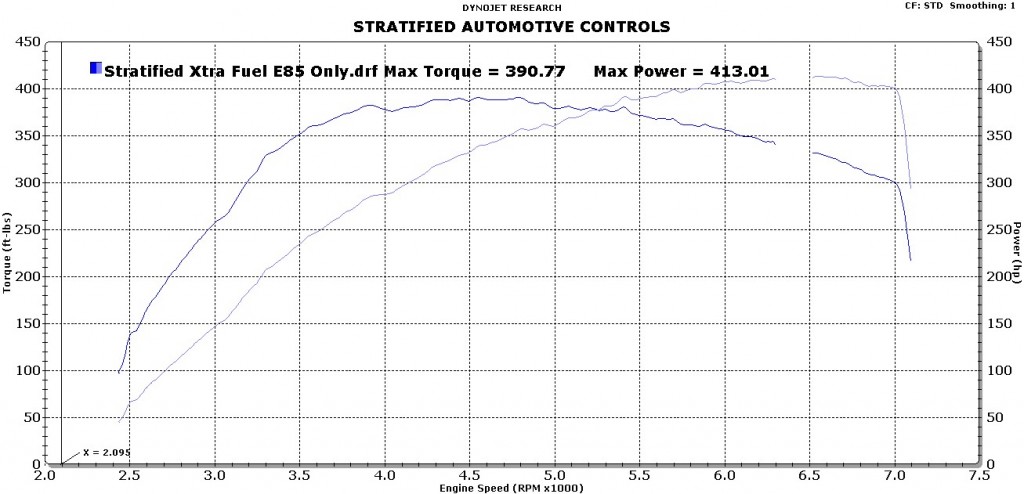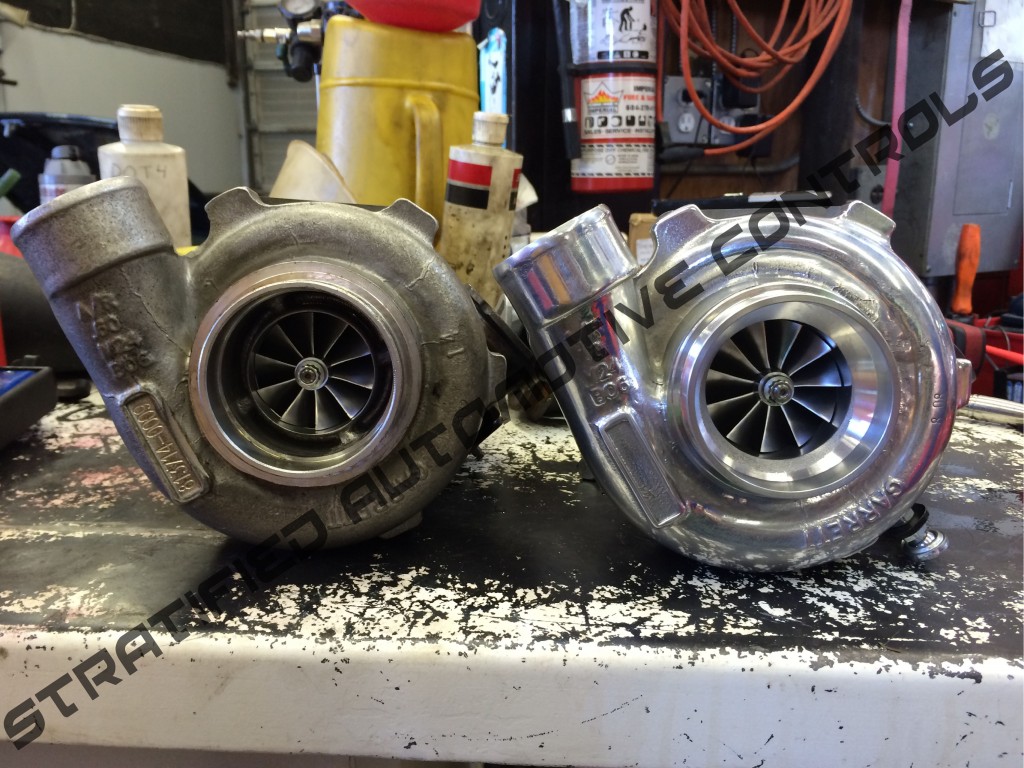Those of you reading this are most likely at the point where you’ve reached the limits of your K03 Turbo and are hungry for more. The OEM K03 is able to deliver between 250-290whp depending on setup but beyond this a bigger turbo is needed. Thankfully, the aftermarket is full of solutions and StratifiedAuto is here to help you get to your goals whatever they may be.
Before we get started, here is the I want power now show me what I need version of this post (tl;dr):
- Stratified Big Turbo Plus Tune Package (Most popular is GTX2867R)
- Stratified Aux Fuel Kit (If E85 or Race Gas Available)
- FMIC, pick one with a good core like ATP (Garrett Core) or CP-e (big core)
- Quality Downpipe
- Aftermarket Intake System
- Water-Methanol Injection (If E85 is not available)
Now onto the details. One of the most common questions we answer is “Which turbo is right for me?”. This is a difficult question as the answer depends on your goals. It is very important to have a clear understanding of your goals before you can set out to reach those goals. A GTX30xx turbo can make 500 whp, however, it will be hard pressed to make much boost before 3,500 RPM. On the other hand, a GTX2860 can reach over 20psi by 3,000 RPM but it will run out of steam up top compared to a GTX3071 turbo.
There is no golden ticket, no turbo will spool like OEM and flow very well up top. That being said, we have enough turbo options that get pretty darn close and maximize the area under the power curve. When looking at turbos for the Ford EcoBoost the comparison is generally between the Borg-Warner EFR and Garrett GTX. The Borg-Warner EFR (Engineered For Race) turbos are more expensive, however, they feature very light weight rotating components which means they are very responsive. The Garrett GTX turbos are a bit less expensive due to a heavier exhaust wheel but they have the ability to bolt on an external wastegate (with the ATP exhaust housing). The GTX also have billet compressor wheels helping them spool quicker and flow more than the older GT series. Garrett GTX turbos are also very reliable and you do not require a new downpipe, charge pipe, and intake which are needed for the EFR.
So, the first question to answer is am I ready for a big turbo?
The minimum we recommend when upgrading the turbo on your Focus ST would be an upgraded intercooler, a high flow air filter, BPV/BOV (for Garrett turbos), and a downpipe. Those of you looking to make more than 350WHP are going to either need a Stratified Aux Fuel Kit or water-methanol injection. We recommend the Stratified Aux Fuel Kit for customers who have exceptional fuel or E85 readily available. For customers who are octane limited and do not have E85 available then WMI is the way to go as it helps bump the fuel octane while also helping with fueling. You can also run both systems for the ultimate fueling and cooling capabilities.
The second question is often Full-Race EFR or ATP Garrett?
Here are some benefits of each kit: Full Race Borg-Warner EFR Kits:
- Integrated BPV
- Big internal waste gate
- Quickest spooling, high flowing
- A little less compressor efficiency compared to the Garrett GTX
- Price includes downpipe, charge pipes, and intake. (Not compatible with downpipe, charge pipe, or intake from a K03 powered turbo car)
ATP Garrett Bolt-On Turbo Kits:
- Billet compressor wheel for quick spool and high flow
- Compatible with OEM fit intakes / charge pipes
- Compatible with external wasteage
- Extremely reliable turbo
- Requires an external BOV
The long and the short is that the EFR turbos are more expensive, however, they generally spool faster than an equivalent Garrett. The Garrett Turbos are more affordable and a little more efficient, however, will spool a little slower than an EFR (of similar size), and require an aftermarket BPV. Most people who already have a bolted car prefer the GTX because they can reuse their parts. If starting from scratch with a bone stock car, the EFR kit includes many of the needed parts (downpipe, intake, charge pipe).
One of the last questions asked is “Do I need to build my block?”
Luckily for us these EcoBoost motors are robust and reliable. How long your motor survives and how much power it can handle will depend on many factors, however, we can still look at the trends and draw a conclusion. Up to around 400WHP things look to be very reliable on a mainly street and drag race car. Even the OEM clutch holds reasonably well up to 400 ftbs/400whp. A poor tune and heat are the biggest enemy of reliability. Ring lands are the first to suffer and these failures are generally the result of too much heat, detonation, and/or poorly setup tunes and parts. If you plan on taking your big turbo ST to a road course make sure the brakes, tires and engine cooling are up to the task. The OEM cooling system must be augmented with at least external oil cooling once you approach the 300whp mark. Our development vehicle which sees daily R&D abuse has been extremely reliable which along with data from many other cars indicate that the Focus ST is reliable and a very good big turbo candidate.
Now, on to the specific turbos:
Below I’ve listed the common Focus ST turbo upgrades from each company in order from smallest to biggest. A smaller turbo will spool faster but flow less than a bigger turbo. Also, remember that anything over ~350whp on a Focus ST is going to require either need a Stratified Aux Fuel Kit with ethanol blended fuel or water-methanol injection.
Full-Race BW EFR Turbo Options:
With the BW EFR turbos the first two numbers are the compressor size while the last two are the turbine size. The turbine size is what most strongly affects how the turbo spools. The compressor determines how much the turbo can flow – its top end potential.
1. EFR 6258:This turbo is the smallest offering available with the Full-Race EFR kits making this the quickest spooling turbo available. This turbo is good for up to 375 whp on a Focus ST with response that is closest to OEM.This turbo will spool faster and flow similarly to a GTX2860 (full boost below 3,000 RPM).
2. EFR 6758: This turbo uses the same turbine as the 6258, however, features a larger compressor. This means you will still get excellent spool while flowing up to around 400 WHP on a Focus ST. Expect spool to be similar to the GTX2863 (or around 2-400 RPM later than the 6258) and flow to be between the GTX2863 and GTX2867.
3. EFR 7163:This is the largest turbo EFR currently offers with their Focus ST kits and features a larger compressor and turbine than both the EFR 6258 and EFR 6758. This is the same turbo which made 459whp on a Stratified Tuned Focus ST. Expect spool similar to the GTX2971 (full boost ~3,700 RPM) and flow between the GTX2971 and GTX3076 turbos.
Garrett GTX Turbo Options:
The GT series turbos have been omitted from this discussion as they are older technology and not a common choice for the Focus ST. Behavior of the GTX turbo is similar to that of the GT turbo, however, the GTX turbos are more efficient across the board. For those of you who did not know, with the Garrett turbos the first two numbers are the turbine size and the second two are the compressor. So, for example, all GTX28xx turbos will have the same turbine. The turbine size is what most strongly affects how the turbo spools and compressor determines the top end flow potential.
1. ATP/Garrett GTX 2860, 2863, 2867, 2871: Featuring a 10-blade compressor wheel and ball bearing center cartridge these turbos provide quicker spool, lower Charge Air Temps, higher boost, and more fun! From this group of turbos the GTX2860 and GTX2863 are less commonly seen due to their lower top end performance compared to the GTX2867. We feel that the GTX2867 is the best match for our 2.0L EcoBoost as it is a responsive turbo which will produce a very broad (flat) torque curve and power up to 420WHP. Expect the GTX2867 to reach 20psi a little below 3000RPM in 4th gear.
2. ATP/Garrett GTX2971, GTX2976: Very similar to the GTX2867 but with more top end and a smidge more lag. These turbos feature a bigger 11-blade billet compressor wheel and slightly bigger turbine wheel. From these two turbos we recommend the GTX2971 as we feel the compressor/turbine are a very good match for each other. Expect spool to be 2-400 RPM later than the GTX2867 with power potential of 420-450WHP. Here are some photos comparing a GTX2867 and GTX2971. The difference in size is quite obvious. 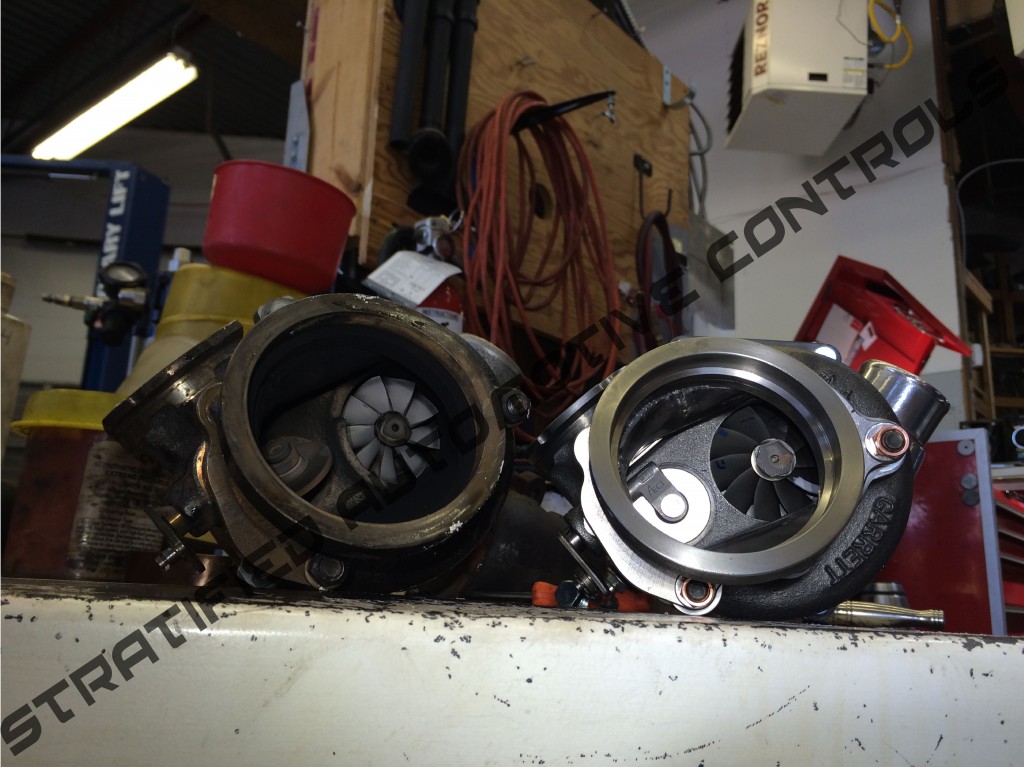
3. ATP/Garrett GTX3071R / GTX3076R: A step up from the GTX2971/GTX2976 these turbos have bigger exhaust fans and thus slower spool and more top end. These turbos also have an 11-blade compressor wheel and ball bearing center cartridge for to help with spool and maintaining flow. These turbos will spool a couple of hundred RPM later than the GTX2971 and will produce more power right to redline. To get the most from one of the larger turbos it is recommended to build the block and run high boost with a high redline. For serious drag racing applications where spool is less important and you are looking for 475+ WHP we recommend one of these turbos and an aux fuel kit.
Wondering what is it you have to look forward to?
Thanks for reading, we hope it helps!
– The Stratified Team


